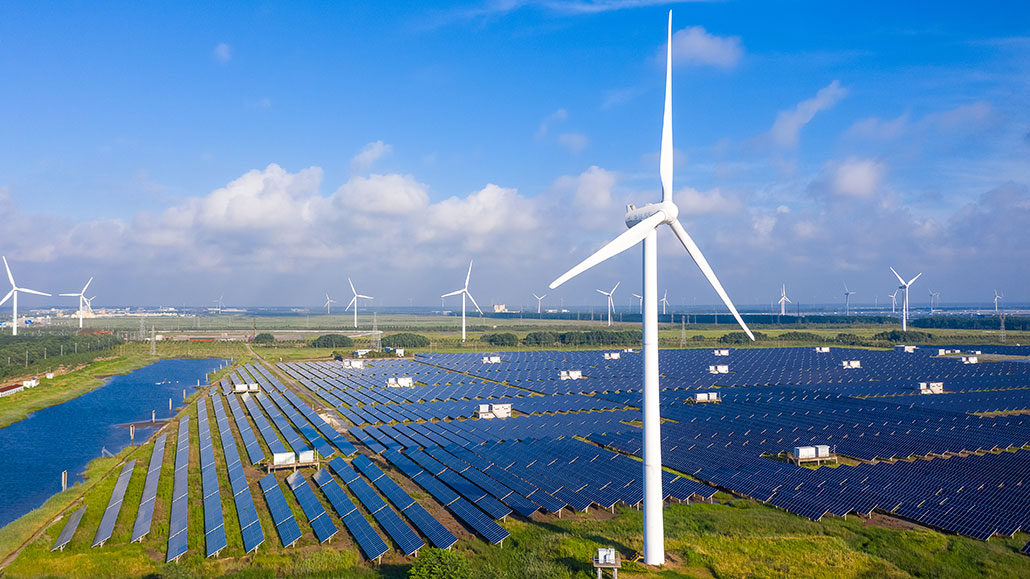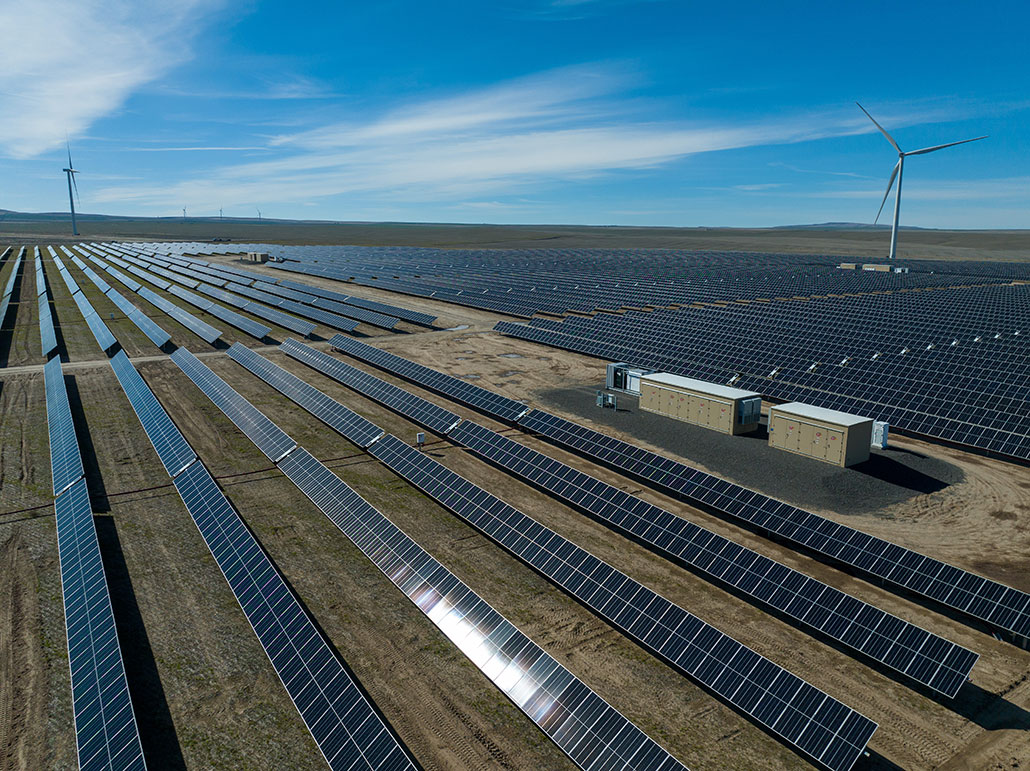Green energy is cheaper than fossil fuels, a new study finds
Making a fast switch to cleaner renewable power could save trillions of dollars by 2050

Wind turbines and solar panels produce energy using free and green sources of power — the sun and wind.
jia yu/Moment/Getty Images Plus
By Laura Allen
On September 15, there was a giant ka-BOOM! And with that, Portland General Electric dynamited Oregon’s last coal-fired power plant into rubble. The company also opened a new power plant on September 28 — what it’s calling the nation’s first large-scale wind and solar generating facility. (Batteries nearby will store the electricity until it’s needed).
Both the old plant and the new one were tasked with generating electricity. But the coal-powered one relied on burning fossil fuels. That spewed carbon dioxide, or CO2, into the atmosphere, which contributes to climate change. For years, economists have said that a switch to cleaner power — such as wind or solar — would be very costly. Such a switch is referred to as “decarbonization.”
But making that switch globally should actually save money, researchers now report. Decarbonizing our energy use could save trillions of dollars over the next 20 years or so. That’s the conclusion of a September 13 paper in Joule.
Doyne Farmer is a scientist in England who studies complex systems. He works at the University of Oxford. “We can do a green-energy transition that replaces fossil fuels with renewables like solar and wind,” he says of his team’s findings. “It’s not just cheap, it will make money.” That, he says, should bring energy prices down.
This might sound surprising. “People think it will cost a lot of money to throw away our whole energy system and replace it,” he says. “But we’re always doing this.” For example, gas stations are replaced about every 25 years. If between now and 2050 we replace each gas station with an electric-vehicle charging station, we’ll reach the climate goal set by many governments.

The role of modeling
Those estimates don’t come from crystal-ball gazing. Farmer’s team has been using big energy simulations known as computer models. No one can know with certainty how much we will pay for energy in the future. That’s why scientists turn to models that can predict this. Their calculations help communities decide what types of energy they should invest in.
Economists have long used such models to predict future energy costs from fossil fuels. Doing this for renewables has proven more challenging. “Fossil fuels cost about the same as they did 100 years ago” once we adjust for inflation, Farmer says. That’s because they’re an old, established technology. In contrast, “the price of solar has dropped by a factor of 5,000 since it was first used in 1958.” In fact, he says, the cost of all renewables, including wind energy and battery storage, has been coming down every year. So, predictions of their future costs can be much trickier.
Farmer was part of a team that in 2010 predicted solar energy would be cheaper than coal-fired electricity by 2020. At the time they wrote this in the journal Nature, people didn’t believe them. They called it “crazy,” he recalls. His group had observed the trends in solar energy costs and assumed they would keep going for the next decade or longer.
And this proved true.
Many economists wrongly predicted the cost of renewables. Why? Farmer says they put assumptions into their computer models that limited how cheap and plentiful clean power could become. But they did not have evidence to support those limits. Data from the past 20 years, he says, now suggest that solar and wind will soon take over in generating electricity. Today, harnessing those renewables is typically cheaper than building new fossil-fueled plants.
Farmer’s team spent a lot of time gathering data on how the cost of renewable energy has dropped as its use has increased. With these data, they created a model to predict future costs. Their model put no limits on how much or little energy could cost.
The model is based on probability — the likelihood that something will happen. To test if this model was accurate, the researchers applied it to past conditions. For example, they set it up as if it were the year 2000 and had it predict what solar power would cost in 2010. They already had data for that year, so they could compare the prediction to what actually happened. They did this many times using different years to see if the model worked. And it did.
Predictions, of course, offer no guarantees. Farmer’s team based its predictions on the assumption that people will continue to install solar, wind and battery storage at the same pace they’ve been doing for the past 20 years. If that occurs, we’ll have a fast transition to clean power. And over that time, they estimate it should save between $5 trillion and $15 trillion dollars.

The switch to electric
Another aspect of this clean-energy transition will happen inside buildings. Many homes and businesses burn natural gas — a fossil fuel — for heating and cooking. Natural gas emits greenhouse gases, as well as other pollutants that can harm health. Gas appliances can be swapped out for electric versions and tap into clean electricity.
Panama Bartholomy is the director of the Building Decarbonization Coalition. His group, based in Petaluma, Calif., focuses on limiting gas emissions indoors. “We assume the [electric] grid is getting cleaner over time, which it is. So, we want more and more of our heating to come from electricity.”
It’s much easier to make these types of changes when governments recommend them, says Beth Miller. She is an ecologist and consultant with Good Company. Based in Eugene, Ore., it helps companies and communities reduce their carbon footprint. Some states are already taking steps to make these changes. On September 22, for instance, California decided it would ban the sale of gas-fired space heaters and water heaters by 2030.

After homes and businesses make the switch to electric alternatives, they will be more comfortable, says Bartholomy. They will be safer and cleaner, too, he adds. Instead of a gas furnace, an electric heat pump could both heat and cool a home. Gas heaters and stoves won’t be pumping pollution into a home’s air. And cooks will have even more control on a modern electric induction cooktop than on a gas stove, says Bartholomy.
Getting fossil fuels out of your home is probably the largest positive impact you can have for the planet, Bartholomy says. “We all need to fight for a livable climate. There is no way to meet our climate goals while still burning gas in buildings. For a livable future, we must stop burning fossil fuels.” And the bonus: It now looks like doing that should also save people a lot of money.







